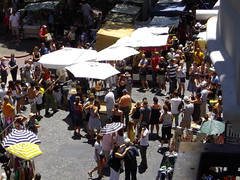Blog Archives
The Grandeur of Ilha Grande
I had believed the massive grey shape across the bay on the horizon to be the mainland, but no, it turned out to be my next destination.
Ilha Grande, aptly named as this island is huge, is mostly an untouched paradise just south of Rio de Janeiro, next to Angra dos Reis.
After docking the ferry at Vila Abraão, pop 6,000, we were greeted by six sandy streets of tourist shops, restaurants, pousadas and bars to choose from. This is the only real village on the island and the main hub of activity.
I grabbed my backpack and walked onwards, asking along the way how to get to my pousada. It turned out to be both awesome and quaint.
A hammock at the front, which you can sit in and read, while small monkeys play in the trees above. The pousada host was friendly, if not a little deaf, so he didn’t quite understand every question, but happily responded to whichever question he thought he heard.
The place was charming. The only downside to pousadas are that they are not as easy to meet other people as at the youth hostels, but then again, you do get your own room, and no one tries to have sex in the bunk above while you sleep. Hehe. Ahhh hostel life…
The island has an interesting history, and was once a leper colony, and also contained a number of prisons. Oh to be trapped in paradise! The unsavory past has helped it’s future though, as the island remained largely undeveloped.
While on Ilha Grande, which is as close to a natural ecosystem that you can still access, there’s plenty to do. Schooner trips, diving, surfing, hiking along the many trails, and bathing in the waterfalls just to name a few…
This island should definitely be added to anyone’s Brazil travel itinerary without hesitation.
Losing Ones-self In History
It’s late in the afternoon, as the bus from Ubatuba shuffles into town. The golden tinge of the setting sun filters through to the colonial dwellings of Paraty.
A once important port for the transport of gold from Brazil to Portugal, the town is now a haven for tourists and artists keen to capture the essence of colonial Brazil.
After a quick refreshing shower at the pousada, it’s back out onto the cobbled streets for a closer look. Most of the buildings, particularly those in the historic centre, are painted white, with the only splashes of colour permitted are on the doors and their frames. It makes for an enticing photo.
The closer you get to the centre, the more Paraty’s charm takes over and you forget you are a tourist in what is quite the tourist attraction. It’s no wonder you see artists with easels out in the streets painting famous scenes of Paraty – this place is blooming beautiful. Touristic – yes. But there’s plenty of places to still lose yourself a little and grab some alone time with the village.
As I head into town, the sun sets and soon the colour of purple evening light adorns Paraty’s whitewashed walls. Night lights soon lead the way to street markets, musicians, shows and some amazing restaurants and ice cream shops.
You might not be able to lose yourself completely in Paraty’s few cobblestone streets, but you’ll definitely lose track of the time you spend in them…









